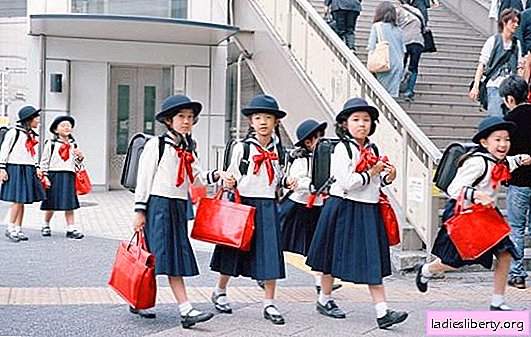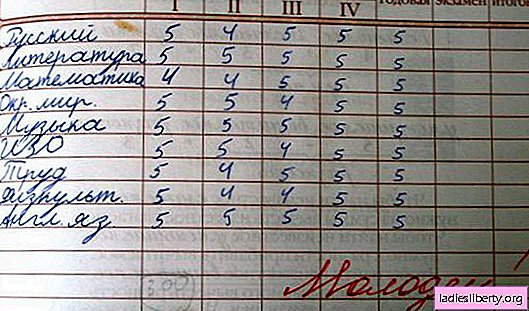
A school grade is simply a number set by a teacher. The assessment process itself is a complex interaction between student and teacher. The first does a great job to get a mark; the second uses a system of pedagogical knowledge and makes pedagogical requirements.
In this interaction, thorough systematic preparation, the student’s IQ level; objectivity, pedagogical tact, individual approach of the teacher. In the minds of many generations, such a stereotype has developed.
But how to perceive the mark in different countries of the world. How to evaluate first graders.
In secondary schools around the world there are a large number of scales for assessing knowledge. Numeric and alphabetic notation, ball system are used. For example, in the USA marks are denoted by the letters:
- A - "Excellent."
- B - "Good."
- C - Satisfactory
- D - Weak.
- F - "Unsatisfactory."
Every American school has a website where information on children's performance is stored in an electronic office. Access to it is available to teachers, each student separately and his parents. Nobody scolds anyone for a poorly or well-performed training function, there are no competitions.

Finnish teachers Do not mark students until they reach the age of twelve. Although parents receive a report on their educational activities twice a year.
What are Finnish educators doing? How do they evaluate the capabilities of children?
Everything is simple: in elementary school they teach them to evaluate themselves, their intellectual level, and understand the weak and strong character traits.
In a Finnish school, every teacher is not only a specialist in his subject, but also a high-level psychologist.
Only after the passed stage of assessing their capabilities, children in grade 6 receive points - from 4 to 10 (there is no zero rating !!!).
In Norway children do not receive marks until the eighth grade. Go to school at 6 years old. Duration of study - 13 years. The assessment system is aimed at motivating children to interact with each other: teamwork and decision making. This is an important factor for the overall development of a first grader.
This approach to learning provides a specific amount of knowledge, not assessment. In order to determine the level of knowledge of primary school children, a special commission is convening.
Its warehouse includes specialists from various fields of school science. It is they who confirm the appropriate level or academic performance, which is reported to parents at the meeting.
Children in japan go to school at the age of six in spring when sakura blooms. The Japanese believe that this order is due to the fact that in spring, nature wakes up and begins a new life. Therefore, young children should begin training at this time. The primary school period is 6 years, and the secondary one is only 3. In Japan, there is no traditional grading system at all.
The teacher evaluates the level of readiness for the lesson in red circle, which surrounds the completed task. But periodically in all subjects students are tested on a 100-point scale. At the end of the year, they do not receive a time sheet with grades, but with the words “good”, “try again”, “very good”. So teachers comment on the level of development of the child, without exerting any moral pressure on him.
In France there is a ball rating system. The highest score is 20. Although, according to French students, only the Lord can receive it. Each semester of students is evaluated in all subjects and sends the results (report card) to parents by e-mail. Many teachers conduct a comparative analysis of academic performance.
The psychological characteristics of the student (behavior, skills) are also attached to the report card.
If the above-mentioned developed countries have already passed the path of reforming education and are now successfully applying the concepts of individual educational programs, instead of traditional lessons, a comprehensive study of topics, the acquisition of critical and creative thinking skills, and the acquisition of knowledge throughout life, anywhere, anytime, any form.
On August 18, 2016, during a pedagogical conference, the Minister of Education and Science of Ukraine L. Grinevich introduced the concept of the “New Ukrainian School”. Prior to this, a 12-point grading system was used. It became interesting for schoolchildren, specialists found options for its replacement by developing the Concept.
Based on the Korean methodology, which is being successfully implemented in 80 countries around the world. In accordance with the new methodology, grades in the first grade are not exhibited. Children will receive them only from the fourth grade.
In Russia children become pupils at the age of 6-8. They study in elementary school for four years.
The main task of teachers is to provide children with a basic amount of knowledge from basic subjects and develop the skills necessary for use in everyday life. The assessment system is a five-point system, which was established by the Ministry of Education in 1837. Although interesting is the fact that as early as the 18th century, the word "Teaching" and its characteristic were used in many theological academies:
- fair, reliable, laudable;
- mediocre, measured;
- weak and lazy.
Regarding the grades in the first grade, the opinions of teachers and parents differ. If you ask any child who comes to school whether he wants to receive marks. He will say yes. This is a very big motivation for a first grader. Parents think so too.
Today, children do not receive current marks in the first grade, they are only given the final marks.
It turns out. that the Russian grading system has not changed for many generations. Stability is an indicator of effectiveness.
Although. There are still some changes. Compare report cards: forty years ago and now.
Report Card 1987

Modern timesheet












